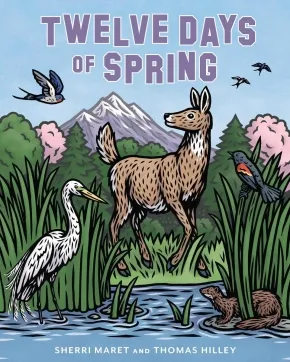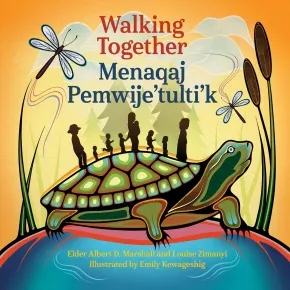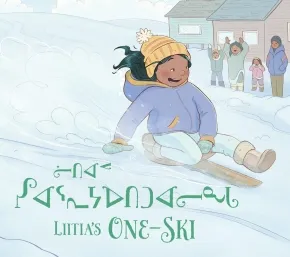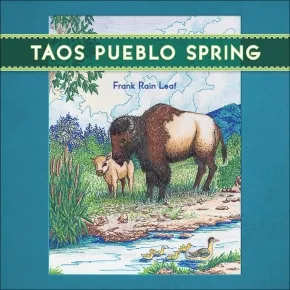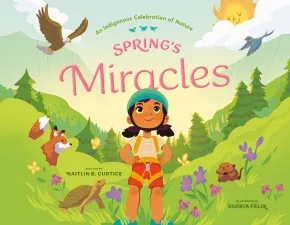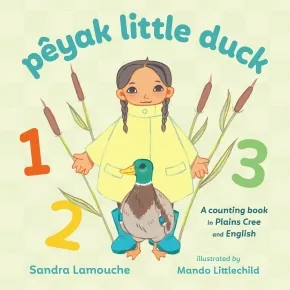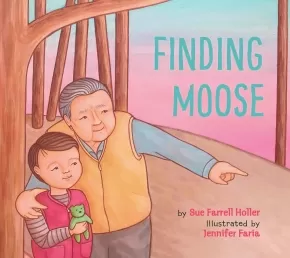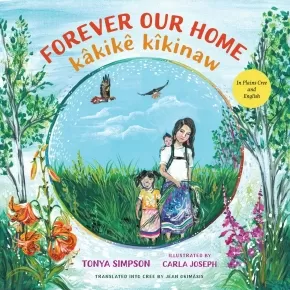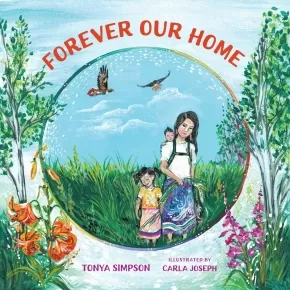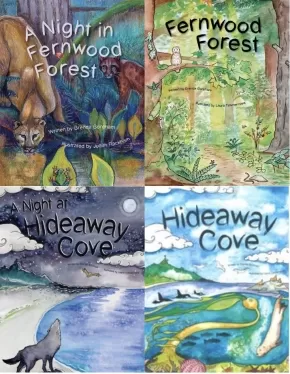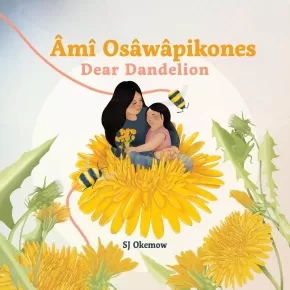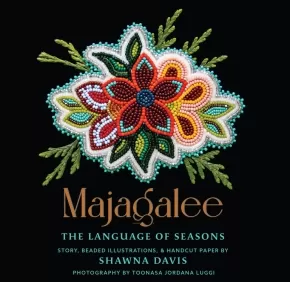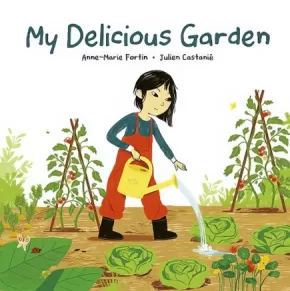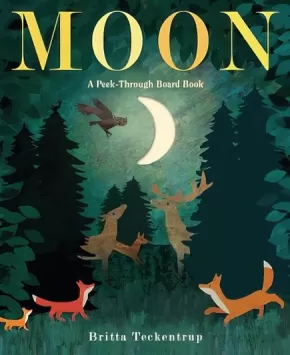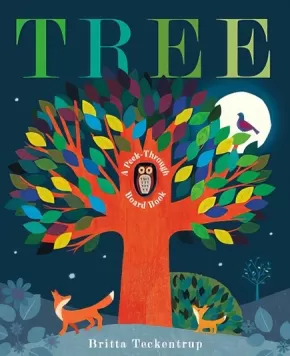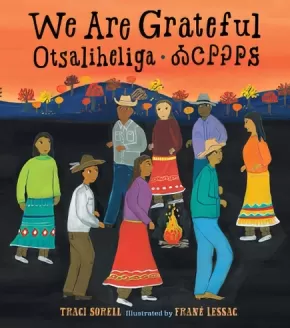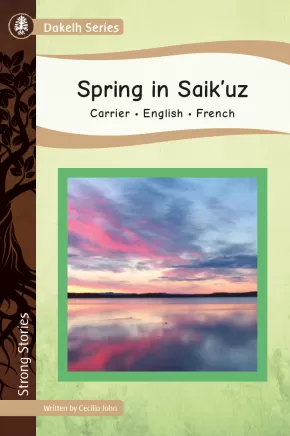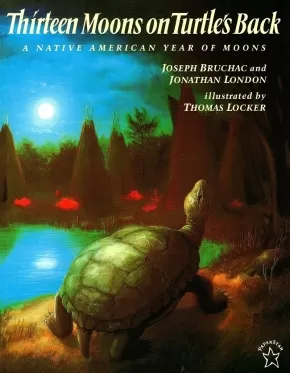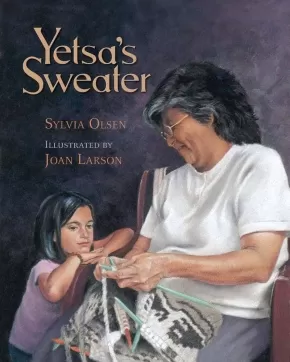
Spring
1
-
15
of
30 Results;
Sort By
Go To
of 2
Twelve Days of Spring
$22.95
Artists:
Format:
Hardcover
ISBN / Barcode: 9781493089246
Synopsis:
Synopsis:
Observe animals and celebrate wildlife in this seasonal twist and reimagined version of “The Twelve Days of Christmas.” In Twelve Days of Spring, each day reveals the wonders of wildlife and nature's vibrant transformations as we ease into spring.
Educator & Series Information
Recommended for ages 3 to 8.
This book is part of the Twelve Days Series.
A rabbit hops through the pages of Twelve Days of Spring.
Additional Information
32 pages | 8.00" x 10.00" | Hardcover
Walking Together / Menaqaj Pemwije’tulti’k
$24.99
Format:
Hardcover
Text Content Territories:
Indigenous Canadian; First Nations; Mi'kmaq (Mi'gmaq);
ISBN / Barcode: 9781834020174
Synopsis:
Synopsis:
This bestselling and award-winning introduction to Etuaptmumk—the gift of multiple perspectives also known as Two-Eyed Seeing—is now available in a bilingual edition that celebrates the Mi’kmaw language and our connections to nature.
Elder Albert D. Marshall is a leading environmental voice who has brought forward the concept of Etuaptmumk, honoring and braiding both Indigenous and non-Indigenous knowledges and ways of knowing for the benefit of all. Walking Together is grounded in this, as well as in the concept of Netukulimk, meaning to protect Mother Earth for the ancestors and for present and future generations. The journey in Walking Together nurtures respectful, reciprocal, responsible relationships with the Land and Water, with plant life and animals, and with other-than-human beings.
Translated by Barbara Sylliboy and Arlene Stevens, Eskasoni First Nation, Unama’ki (Cape Breton), Nova Scotia, the dual-language text in Mi’kmaw and English furthers Elder Marshall’s lifelong work preserving cultural beliefs and creating a strong vision for his people and for the future. Elder Marshall and Louise Zimanyi are working together to promote Land-based learning through storytelling, an approach that has global relevance for protecting biodiversity, climate action, and resilience. Emily Kewageshig’s evocative artwork illustrates the beauty of connecting with nature and encourages readers to strengthen their relationships to the world around them.
Educator Information
Recommended for ages 4 to 7.
Introduces the concept of Two-Eyed Seeing (the gift of multiple perspectives) to young readers.
Bilingual Edition: Mi’kmaw and English.
This book is available in English: Walking Together
Additional Information
40 pages | 9.00" x 9.00" | Hardcover
Liitia's One-Ski
$16.95
Artists:
Format:
Paperback
Text Content Territories:
Indigenous Canadian; Inuit;
Grade Levels: Preschool; Kindergarten;
ISBN / Barcode: 9781774508091
Synopsis:
Synopsis:
Liitia can't wait to compete in the one-ski race, but she will need practice and a little help if she wants to win!
Liitia lives in Qausuittuq (Resolute Bay), Nunavut, where there is a one-ski race at the end of each spring. Liitia's grandma was always the fastest racer when she was a child, and Liitia wants to race too! She is determined to win the race at the end of the season, even with her old rusty one-ski. Join Liitia in this bilingual picture book as she prepares for the race with a little help from her Grandma.
Educator & Series Information
Recommended for ages 3 to 5.
Liitia’s One-Ski is about a young girl in Resolute Bay, Nunavut, who wants to race in a community one-ski competition. The story is inspired by a real championship that took place and the author’s memories of one-skiing while growing up in Resolute Bay.
In this story, Liitia learns the importance of trying your best and not giving up when faced with challenges as she works toward her dream. This story also demonstrates the value of good sportsmanship and supporting each other as the competition brings people together.
This bilingual storybook is part of our Community Connections series, which is a collection of fun and engaging stories from Inuit authors that celebrate Nunavut communities.
Dual-language: English and Inuktitut
Additional Information
27 pages | 8.00" x 10.00" | Paperback
Taos Pueblo Spring (BB)
$14.95
Artists:
Format:
Board Book
Text Content Territories:
Indigenous American; Native American; Taos Pueblo;
Grade Levels: Preschool;
ISBN / Barcode: 9781570674143
Synopsis:
Synopsis:
This delightful board book, written without text, was created by the Taos Pueblo's Tiwa Language Program to preserve the Tiwa culture and revitalize the Tiwa language by teaching it to younger generations. Many other Indigenous languages also need revitalizing, so it is the hope of the Taos Pueblo's Tiwa Language Program that other American Indian Nations will find the books in the Toas Pueblo Four Seasons series useful to teach their language to young children. The beautiful, hand-drawn illustrations will also teach young children about the four seasons of the year. All proceeds of the book support the Taos Pueblo's Tiwa Language Program.
This text-free board book allows Indigenous nations to teach their own languages to children.
Educator & Series Information
This wordless book is part of the Taos Pueblo Four Seasons series.
We are the "Red Willow People" of Taos Pueblo and have sustained our ancient village as one of the longest continuously inhabited communities, for over 1,000 years. Taos Pueblo is located in northern New Mexico and our Tiwa language is a dialect of the Tanoan language, which is not a written language. Traditionally we learn our Tiwa Language through oral tradition but we are in danger of losing our ancient language due to colonization, modernization, and the shift from Tiwa as our first language to English as our first language. The efforts of the Taos Pueblo Tiwa Language Program are focused on revitalizing the Tiwa Language and culture by protecting and preserving it, through teaching it to our younger generations.
This text-free board book allows Indigenous nations to teach their own languages to children.
Additional Information
22 pages | 8" x 8" | Board Book
Spring's Miracles
$19.99
Artists:
Format:
Hardcover
Text Content Territories:
Indigenous American; Native American; Anishinaabeg; Potawatomi;
ISBN / Barcode: 9780593577851
Synopsis:
Synopsis:
A vibrantly illustrated children's book about an Indigenous girl who discovers the miracles that blossom each spring and learns how Creator's gift of courage can transform the way we see the world and ourselves.
It’s time to welcome a new season, and this spring is going to be extra special. Dani, a Potawatomi girl, and her family prepare to celebrate the new year, which the Potawatomi and other Anishinaabe people observe at the beginning of spring with a camping and climbing trip. Dani is excited for the adventure, but also nervous. The rocks are so big. Will she make it to the top of her climb? As Dani explores the awakening woods and makes memories with her family, she learns to draw on the courage Creator gives while finding inspiration in the miraculous new life Mother Earth brings forth each spring.
Educator & Series Information
Recommended for ages 3 to 7.
This book is part of the An Indigenous Celebration of Nature series.
Additional Information
40 pages | 11.00" x 8.5" | Hardcover
pêyak little duck
$21.95
Artists:
Format:
Hardcover
Text Content Territories:
Indigenous Canadian; First Nations; Cree (Nehiyawak); Plains Cree;
Grade Levels: Preschool; Kindergarten;
ISBN / Barcode: 9781459837171
Synopsis:
Synopsis:
Let's go on a walk and practice our language!
What birds will we see? I see one sîsîp / pêyak little duck!
In a celebration of the connection between language learning and the land, a young child enjoys a walk in nature and spots different birds while practicing counting from one to ten in Plains Cree. With bright illustrations, rhyming clues in English and pronunciation guides on every page, pêyak little duck is a friendly introduction to Plains Cree and a celebration of the beauty of springtime in the Prairies and the Plains.
Educator Information
Recommended for ages 3 to 5.
Learn to count from one to ten in Plains Cree.
Simple rhyming English text complements Plains Cree vocabulary to help readers learn and practice the numbers one through ten. Illustration labels for birds and other natural objects are an opportunity for additional language learning.
Pronunciations are given beside each Cree number to support readers in their learning. The rhyme and rhythm of the English text also provides clues about how the Cree is pronounced. Additional pronunciations and information about language learning are provided in the back matter.
Additional Information
32 pages | 9.00" x 9.00" | Hardcover
Walking Together (PB)
$12.99
Format:
Paperback
Text Content Territories:
Indigenous Canadian; First Nations; Mi'kmaq;
ISBN / Barcode: 9781773217772
Synopsis:
Synopsis:
This bestselling, innovative picture book introduces readers to the concept of Etuaptmumk—or Two-Eyed Seeing, the gift of multiple perspectives in the Mi’kmaw language—as we follow a group of young children connecting to nature as their teacher.
A poetic, joyful celebration of the Lands and Waters as spring unfolds: we watch for Robin's return, listen for Frog's croaking, and wonder at maple tree's gift of sap. Grounded in Etuaptmumk, also known as Two-Eyed Seeing—which braids together the strengths of Indigenous and non-Indigenous ways of knowing—and the Mi’kmaq concept of Netukulimk—meaning to protect Mother Earth for the ancestors, present, and future generations—Walking Together nurtures respectful, reciprocal, responsible relationships with the Land and Water, plant-life, animals and other-than-human beings for the benefit of all.
Reviews
"Walking Together is a poetic celebration grounded in Etuaptmumk (Two-Eyed Seeing) that weaves together the strengths of Indigenous and non-Indigenous ways of knowing. The story explores respectful, reciprocal, responsible relationships between the land, water, plants, animals, and humans." - The Dalai Lama Center
Educator Information
Recommended for ages 4 to 7.
Introduces the concept of Two-Eyed Seeing (the gift of multiple perspectives) to young readers.
This book is available in a bilingual format: Walking Together / Menaqaj Pemwije’tulti’k
Additional Information
36 pages | 8.90" x 8.90" | Paperback
When We Gather (Ostadahlisiha): A Cherokee Tribal Feast
$24.99
Artists:
Format:
Hardcover
Text Content Territories:
Indigenous American; Native American; Cherokee;
ISBN / Barcode: 9780063076792
Synopsis:
Synopsis:
Nothing welcomes spring like a wild onion dinner!
As the dirt warms and green sprouts poke up, a Cherokee girl joins her family in the hunt for green onions. Together, they pick enough to bring to a feast, which is cooked with love and shared by their community.
Idalisdayvhvga!
Let’s all eat!
Written with simple, sensory lyricism by Andrea Rogers (Cherokee) and featuring warm, vibrant art by Madelyn Goodnight (Chickasaw), this picture book celebrates the spring tradition of wild onion dinners—and the community and comfort that are shared when we gather.
Educator Information
Recommended for ages 4 to 8.
Additional Information
40 pages | 8.00" x 10.00" | Hardcover
Finding Moose
$21.95
Artists:
Format:
Hardcover
Text Content Territories:
Indigenous Canadian; First Nations; Anishinaabeg; Ojibway;
ISBN / Barcode: 9781772782448
Synopsis:
Synopsis:
The creators of Raven, Rabbit, Deer are back with another thoughtful tale of a young boy and his grandfather taking a walk through the woods and all the creatures and plants they encounter.
Walking as “quiet as mice and rabbits and deer” they come upon fresh moose droppings and set out to find the moose itself. They discover the branches where the moose ate breakfast, greet a chipmunk and goose, and inspect rosehips and pussy willows, but the moose is nowhere to be found. Finally, after accepting that they will have to try again next time, the boy and his grandfather head home… only to be met with a big surprise.
In Finding Moose, Governor General’s Award-nominated author Sue Farrell Holler gives us a glimpse into the wondrous world of nature through the eyes of a curious child. Grandpa quietly encourages this curiosity while offering answers and further lessons where he can. Illustrator Jennifer Faria draws us in with gentle paintings that make us want to reach out and touch the scenery.
Reviews
“For a lovely early spring walk, learning about nature and being introduced to words in Ojibwemowin, join an Anishinaabe grandfather with his grandson to see how forest life reveals itself and search for an elusive mooz.”—CanLit for LittleCanadians
“Children will enjoy this simple story that introduces them to some of their forest neighbours whose names are in both English and Ojibwemowin. Highly recommended.”— Simcoe.com
“[T]his joyful book reinforces the need to listen, see, and be present in the woods so that the wonders of nature can unfold. The power of loving inter-generational relationships rests at the core of this simple story… The end result is a touching story that addresses important lessons at a time when environmental change is such a pressing concern.”—Children’s Literature
Educator Information
Recommended for ages 3 to 6.
Additional Information
32 pages | 9.00" x 8.00" | Hardcover
Forever Our Home / kâkikê kîkinaw
$21.95
Artists:
Format:
Hardcover
Text Content Territories:
Indigenous Canadian; First Nations; Cree (Nehiyawak); Plains Cree; Pasqua First Nation;
Grade Levels: Preschool; Kindergarten;
ISBN / Barcode: 9781459837584
Synopsis:
Synopsis:
A lullaby of reconciliation and reclamation, celebrating the ancestral relationship between Indigenous children and the land that is forever their home.
Under glowing morning sun and silvery winter moon, from speckled frogs croaking in spring to summer fields painted with fireweed, this meditative lullaby introduces little ones to the plants and animals of the Prairies and the Plains. Featuring stunning artwork by celebrated artist Carla Joseph, Forever Our Home is a beautiful and gentle song about our spiritual connection to the land.
Reviews
A tender hymn to the prairie in all seasons...Uplifting and joyous." — Kirkus Reviews
Educator Information
Recommended for ages 3 to 5.
Written in both Plains Cree and English and featuring stunning artwork by celebrated artist Carla Joseph, Forever Our Home / kâkikê kîkinaw is a beautiful and gentle song about our spiritual connection to the land.
Find the English version here: Forever Our Home
Additional Information
32 pages | 9.00" x 9.00" | Hardcover
Forever Our Home
$21.95
Artists:
Format:
Hardcover
Text Content Territories:
Indigenous Canadian; First Nations; Cree (Nehiyawak); Plains Cree; Pasqua First Nation;
Grade Levels: Preschool; Kindergarten;
ISBN / Barcode: 9781459835634
Synopsis:
Synopsis:
A lullaby of reconciliation and reclamation, celebrating the ancestral relationship between Indigenous children and the land that is forever their home.
Under glowing morning sun and silvery winter moon, from speckled frogs croaking in spring to summer fields painted with fireweed, this meditative lullaby introduces little ones to the plants and animals of the Prairies and the Plains. Featuring stunning artwork by celebrated artist Carla Joseph, Forever Our Home is a beautiful and gentle song about our spiritual connection to the land.
Reviews
A tender hymn to the prairie in all seasons...Uplifting and joyous." — Kirkus Reviews
Educator Information
Recommended for ages 3 to 5.
This book is available in a the dual-language format (English and Plains Cree): Forever Our Home / kâkikê kîkinaw
Additional Information
32 pages | 9.00" x 9.00" | Hardcover
Strong Science - Animals: Mother and Baby Raccoons
 $7.50
$7.50

Artists:
Format:
Paperback
Text Content Territories:
Indigenous Canadian;
Grade Levels: Kindergarten; 1;
ISBN / Barcode: 9781771746137
Synopsis:
Synopsis:
This story is about the home mother raccoon makes in a tree for her babies. The home is called a den.
There are four seasons in the year: winter, spring, summer, and fall. Which season is this story about?
Educator & Series Information
Recommended for grade 1 students, but may also be useful in kindergarten classrooms.
Strong Science - Animals is a language-based science series for primary students featuring animals that all Canadian students will recognize. Photographs and Indigenous artwork illustrate the series. Common learning objectives in science curricula across Canada are addressed, and suggestions for extending the learning to other curriculum areas, including Indigenous cultural awareness, language arts, math, and art, are included in the teacher’s guide. The sixteen books in this series are grouped into four levels that increase in complexity, designed to accommodate students with various reading abilities within a classroom. This feature facilitates the use of this series in literacy programs along with the Strong Readers series.
Mother and Baby Raccoons is an EP3 (Early Primary 3) book in the Strong Science - Animals series. Font size decreases as language complexity and word count increase across levels: EP1 books have approximately 40 words, EP2 books have approximately 60 words, EP3 books have approximately 80 words, and EP4 books have approximately 100 words.
A teacher's guide for Strong Science - Animals is available: Strong Science - Animals: Teacher's Guide
Authenticity Note: This book has received the Indigenous Text label because the author is Indigenous (Lakota) and the featured animal holds cultural significance in many Indigenous cultures. The engaging story provides factual information in an easy-to-read format for children to learn science concepts and build literacy skills. It promotes respect for animals and Mother Earth, and its illustrations communicate additional cultural information through Lakota symbolism and designs. Further cultural connections are identified in the teacher's guide. Refer to the guide to explore the book's Indigenous connections fully. It is up to readers to determine if the book will work as a stand-alone authentic Indigenous text for their purposes.
Additional Information
16 Pages | 6.5" x 5.5" | Paperback | ISBN: 9781771746137
By Day and By Night Nature Series Bundle
 $72.32 $80.35
$72.32 $80.35

ISBN / Barcode: 9781771746014
Synopsis:
Synopsis:
This bundle includes all four titles in the By Day and By Night Nature Series:
- Hideaway Cove (hardcover)
- A Night at Hideaway Cove (paperback)
- Fernwood Forest (hardcover)
- A Night in Fernwood Forest (hardcover)
Each book in the By Day and By Night Nature Series focuses on a scene typical of a distinct west coast habitat, showing how living and non-living things are connected in a healthy ecosystem. As readers, we observe animals going about their daily activities: caring for their young, searching for food, and responding to the changes in light, temperature, and weather conditions throughout the day or night. The last four pages of each book provide facts about the highlighted animals and plants as well as features that are unique to their habitats. The final page suggests ways that young readers and their families can be respectful as they visit wilderness areas.
Readers with a sense of curiosity will find opportunities in these books to:
- use picture clues to predict the featured animal on the next page
- identify, count, and sequence numbers (1 owl, 2 deer, 3 squirrels, etc.)
- search for small creatures that travel from page to page
- discover patterns in the text and structure of the books
- track the movement of the sun, or moon, across the sky
Reading Level: Nonfiction text features such as headings, bold words, bullets, captions, and labelled diagrams make these books accessible to independent readers in grades 2 to 4. The books would also be great “read-alouds” for younger children.
Curriculum Links
Reading - Providing opportunities for guided practise in using reading strategies: visualizing, making connections, asking questions, transforming, and inferring.
Science - Supporting discussion and further exploration:
- characteristics of living things
- needs of living things
- connections between living and non-living things
- daily and seasonal changes
- animal growth and changes
- plant growth and changes
- weather
- habitats
- observable patterns in the sky
Numeracy - Counting and sequencing of numbers 1 to 10.
Social Responsibility - Initiating discussions about ways to take care of wilderness areas.
Lesson plans are available for each book and are free to download from each book's listing on our website!
Additional Information
Titles included are 32 pages, 8.5" x 11"
Please note: All books in this bundle are hardcovers, except for A Night at Hideaway Cove, which is a paperback as the hardcover edition is out of print.
Âmî Osâwâpikones (Dear Dandelion)
$23.99
Artists:
Format:
Hardcover
Text Content Territories:
Indigenous Canadian; First Nations; Cree (Nehiyawak); Plains Cree;
ISBN / Barcode: 9781773217406
Synopsis:
Synopsis:
A debut picture book that celebrates self-love, care, and resilience with one of the most widespread plants—the dandelion.
Both a love letter to the dandelion and a call to love ourselves in a difficult world, Âmî Osâwâpikones reminds us that we are not defined as others see us. Following our young protagonist and the dandelions through the seasons, we are reminded that we are resilient, we are healers, we are funny, and we are loved.
Reviews
“A playful, lyrical, and persuasive love letter to a dandelion ... This tribute to a precious flowering plant will capture readers’ hearts.” —Kirkus Reviews
“SJ combines her gifts as both author and illustrator in this beautiful and endearing book that both children and adults will adore.” —Monique Gray-Smith
Educator Information
Recommended for ages 4 to 7.
Includes some Cree words (y-dialect - Plains Cree). Plains Cree translations and a pronunciation guide can be found at the back of the book.
Includes an Author's Note that describes the inspiration for this story.
Themes: self-love, resilience, care, and lightheartedness conveyed through the dandelion.
This book is available in French: Âmî Osâwâpikones / Cher pissenlit
Additional Information
40 pages | 9.00" x 9.00" | Hardcover
Majagalee: The Language of Seasons
$22.00
Artists:
Format:
Hardcover
Text Content Territories:
Indigenous Canadian; First Nations; Gitxsan (Gitksan);
ISBN / Barcode: 9781990458002
Synopsis:
Synopsis:
Shawna Davis invites the reader to explore each of the four seasons through her beautiful words and lush, unforgettable, beaded illustrations.
We begin in Gwooyim (Spring) when the Majagalee, the Sim Algyax word for “flower,” are just beginning to sprout. We then move on to Sint (Summer) when Grandmother Sun stays in the sky a bit longer. Next there is Xwsit (Fall), just as Summer begins to get sleepy, and Maadim (Winter) where the snow has fallen and the freezer is full.
This is a story of nature, its importance to our lives, and why it must be cared for and respected.
Toonasa Jordana Luggi’s lovely, rich, and nearly tactile photographs are the perfect complement to Shawna’s hand-beaded artwork and wonderful, hand-cut paper backgrounds.
Includes Pronunciation Guides.
Reviews
“...simple, evocative poetry is culturally specific, rooted in a deep love of the land and the people around her but it’s also relatable to readers of different backgrounds. The lyrical verse in Majagalee makes it an ideal read-aloud book.... Majagalee is an elevated concept book. It introduces readers to the seasons, the plants and animals of the Northwest Coast, Sim Algyax, Indigenous art, and the importance of all these things to Gitksan culture. Despite its apparent simplicity, Majagalee is a complex and brilliantly constructed book. It will appeal to Indigenous and non-Indigenous readers alike, and for teachers and parents, it serves as an outstanding example of a book that demonstrates the ongoing presence and beauty of Indigenous cultures in what is now known as Canada..” – Quill & Quire, starred review
Educator Information
Juvenile Fiction. This picture book explores the four seasons on the northwest coast of what is currently British Columbia from a Gitksan perspective.
Additional information
Pages: 40
My Delicious Garden
$18.95
Artists:
Format:
Hardcover
ISBN / Barcode: 9781771474689
Synopsis:
Synopsis:
A girl lovingly tends to her garden through the seasons.
In the depths of winter, one young girl is already dreaming of planting her very own vegetable garden. In January, she sketches out the rows of lettuce, the trellis for the peas, and a large plot for the tomatoes while she waits for warmer weather. March is time for sowing, and April gives way to the first leaves of her seedlings.
As the seasons change from spring to summer, she (with the help of her moms) spreads compost and turns up the soil to finally plant her veggies into the earth. As the months go by, she lovingly weeds, waters, and cares for her garden until it’s time to harvest a bounty big enough to share with all their friends! My Delicious Garden celebrates the joy of growing food from seed and is a cozy exploration of the connections between nature, food, and community.
Reviews
"The unique monthly focus is an interesting and helpful take on gardening; readers will learn about different types of vegetables and flowers equally. Whether there is a garden at school or not, this is a charming addition to the shelves and could be adapted to a very early science lesson for preschoolers, too." — School Library Journal
"All children will be inspired to grow their own gardens, and those children who live in urban environments will understand and appreciate the work, time, and patience, not to mention the joy and sense of accomplishment, it takes to maintain a garden." — School Library Connection
Educator Information
Recommended for ages 4 to 8.
Keywords and Themes: Gardening, Science, Nature, Cooking, Food, Outdoor Activities, Outdoor Learning
Additional Information
24 pages | 9.00" x 9.00" | Hardcover
Moon: A Peek-Through Board Book
$13.99
Artists:
Format:
Board Book
Grade Levels: Preschool;
ISBN / Barcode: 9780593372395
Synopsis:
Synopsis:
From the popular series that launched with Tree: A Peek-Through Picture Book comes a book with peek-through holes that show the moon's different phases with each turn of the page.
Over deserts and forests, Arctic tundra and tropical beaches, the moon shines down on creatures around the world. Children will love discovering how it changes from day to day as the lunar cycle is shown through clever peek-through holes, each revealing the moon in a different size and shape.
It's the perfect light nonfiction book for young stargazers—and an ideal bedtime book, ending with a giant moon hovering over a sleepy town hunkered down for bed.
Educator Information
For ages 3 and under.
Concepts: Seasons, Science, Nature, Astronomy.
Additional Information
26 pages | 6.13" x 7.56" | Board book
Tree: A Peek-Through Board Book
$13.99
Artists:
Format:
Board Book
Grade Levels: Preschool;
ISBN / Barcode: 9780593181775
Synopsis:
Synopsis:
A peek-through board book with elaborate die-cuts on each page showing a tree and its many inhabitants throughout the four seasons.
Through a hole in the book's cover, an owl invites you inside to meet a majestic tree and all its forest inhabitants during the changing seasons. With clever die-cuts throughout, each sturdy page reveals a new set of animals playing and living in the tree--baby bears frolicking in the spring, bees buzzing around apples in the summer, squirrels storing nuts in the fall, and finally the lone owl keeping warm during the winter chill, until another year begins. . . .
Children will love seeing a new set of animals appear as each page is turned, and along the way they'll learn about the seasons and how a forest and its inhabitants change throughout the year.
Educator Information
For ages 3 and under.
Concepts: Seasons, Science, Nature, Animals.
Additional Information
26 pages | 6.13" x 7.50" | Board book
Bebikaan-ezhiwebiziwinan Nimkii: The Adventures of Nimkii
$30.00
Artists:
● Butzin Rachel (Indigenous;)
Format:
Hardcover
Text Content Territories:
Indigenous American; Native American; Anishinaabeg; Ojibwe (Chippewa); Indigenous Canadian; First Nations; Anishinaabeg; Ojibway;
ISBN / Barcode: 9781736551912
Synopsis:
Synopsis:
In this beautifully illustrated children’s book, readers will experience the world in a new way as they see the seasons through the joyful eyes of Nimkii, a fun, nature-loving dog who will teach them a whole new language: Ojibwemowin, a language spoken by the indigenous tribes in parts of Michigan, Ontario, northern Minnesota and Wisconsin, and Alberta.
Whether hunting for maple trees in the fall, playing in the snow in the winter, enjoying the spring showers, or swimming in the summer, Nimkii seeks out activities that allow her to enjoy her natural surroundings. Fun and inspiring, this bilingual book helps children and adults communicate in new ways while exploring different elements of culture.
Educator Information
Children's Literature
Dual-language: English and Ojibwemowin
Translated by Margaret Noodin, of the Pine Marten Clan.
Additional Information
38 pages | 11.00" x 8.50" | Hardcover
Mii maanda ezhi-gkendmaanh / This Is How I Know
$19.99
Format:
Hardcover
Text Content Territories:
Indigenous Canadian; First Nations; Anishinaabeg;
ISBN / Barcode: 9781773063263
Synopsis:
Synopsis:
Niibing, dgwaagig, bboong, mnookmig dbaadjigaade maanpii mzin'igning / A Book about the Seasons.
An Anishinaabe child and her grandmother explore the natural wonders of each season in this lyrical, bilingual story-poem.
In this lyrical story-poem, written in Anishinaabemowin and English, a child and grandmother explore their surroundings, taking pleasure in the familiar sights that each new season brings.
We accompany them through warm summer days full of wildflowers, bees and blueberries, then fall, when bears feast before hibernation and forest mushrooms are ripe for harvest. Winter mornings begin in darkness as deer, mice and other animals search for food, while spring brings green shoots poking through melting snow and the chirping of peepers.
Brittany Luby and Joshua Mangeshig Pawis-Steckley have created a book inspired by childhood memories of time spent with Knowledge Keepers, observing and living in relationship with the natural world in the place they call home — the northern reaches of Anishinaabewaking, around the Great Lakes.
Alvin Ted Corbiere and Alan Corbiere, father and son, are the Anishinaabe translators of this work.
Awards
- 2022 Indigenous Voices Award for a published work in an Indigenous language
Educator Information
Recommended for ages 3 to 7.
Correlates to the Common Core State Standards in English Language Arts:
CCSS.ELA-LITERACY.RL.2.1
Ask and answer such questions as who, what, where, when, why, and how to demonstrate understanding of key details in a text.
CCSS.ELA-LITERACY.RL.2.2
Recount stories, including fables and folktales from diverse cultures, and determine their central message, lesson, or moral.
CCSS.ELA-LITERACY.RL.K.6
With prompting and support, name the author and illustrator of a story and define the role of each in telling the story.
CCSS.ELA-LITERACY.RL.1.4
Identify words and phrases in stories or poems that suggest feelings or appeal to the senses.
CCSS.ELA-LITERACY.RL.2.5
Describe the overall structure of a story, including describing how the beginning introduces the story and the ending concludes the action.
How do you know the seasons? Do you know it's summer when blueberries fall readily and the sand is hot enough to sting? Do you know fall by the red-winged blackbird taking his leave? Take a minute and look around — nature is speaking to us. Changes are happening, and Mother Earth is letting us know at every step of the way. Whether it's the sun's bright morning light, or the white moon sitting high in the sky, there are many ways to know what time of the year it is. All we need to do is stop, look, and listen, because each season tells us a story!
This book is also available in French and Ojibwe: Mii maanda ezhi-gkendmaanh / La Terre me parle: Un livre sur les saisons
Additional Information
44 pages | 8.75" x 8.50"
Celebrating Toonik Tyme - Nunavummi Reading Series
$7.95
Artists:
● Tim Mack
Format:
Paperback
Text Content Territories:
Indigenous Canadian; Inuit;
ISBN / Barcode: 9781774501801
Synopsis:
Synopsis:
Toonik Tyme is a lot of fun!
This book describes different things that happen during Toonik Tyme, an annual festival in Iqaluit that celebrates Inuit traditions and the return of spring.
Educator & Series Information
This book is part of the Nunavummi Reading Series, a Nunavut-developed series that supports literacy learning while teaching readers about the people, traditions, and environment of the Canadian Arctic. It is a Level 7 book in the series.
Nunavummi Reading Series books have also been officially levelled using the Fountas & Pinnell Text Level Gradient™ Levelling System. This book's F&P Level is E.
Curriculum Connections: Language and literacy; Indigenous perspectives; Community engagement; History; Heritage
Recommended for ages 5-7.
Additional Information
16 pages | 10.00" x 10.00"
We Are Grateful: Otsaliheliga
$21.99
Artists:
Format:
Hardcover
Text Content Territories:
Indigenous American; Native American; Cherokee; Cherokee Nation (Cherokee Nation of Oklahoma);
ISBN / Barcode: 9781580897723
Synopsis:
Synopsis:
The Cherokee community is grateful for blessings and challenges that each season brings. This is modern Native American life as told by an enrolled citizen of the Cherokee Nation.
The word otsaliheliga (oh-jah-LEE-hay-lee-gah) is used by members of the Cherokee Nation to express gratitude. Beginning in the fall with the new year and ending in summer, follow a full Cherokee year of celebrations and experiences. Written by a citizen of the Cherokee Nation, this look at one group of Native Americans is appended with a glossary and the complete Cherokee syllabary, originally created by Sequoyah.
Awards
- 2019 Sibert Honor Book
- NPR's Guide to 2018's Great Reads
- Kirkus Reviews Best Books of 2018
- 2018 Book Launch Award (SCBWI)
Reviews
"According to storyteller Sorell, the Cherokee people always express gratitude for the little things they are given by saying the phrase, "Otsaliheliga," or "we are grateful." Raised in the Cherokee Nation, Sorell intentionally crafts a narrative that simultaneously embraces modernity and a traditional presentation of Cherokee community and way of life. Throughout, the measured text reminds readers that in all things "we say otsaliheliga." Colorful, folk art-style illustrations show Cherokee people during ceremonies, in family gatherings large and small, and outdoors enjoying each of the four seasons, always expressing gratitude. The scenes are contemporary; one shows a father taking care of his children, engaging in a positive parenting role, while another depicts a family seeing off a relative who is leaving for deployment in the military, underscoring that Cherokee people serve their country. Children participate in rites and in family outings with adults, and they also play traditional games such as stickball and plant strawberries, a practice that reminds their people to embrace peace with one another. The variety of skin tones represented in the illustrations likewise depicts a present-day reflection of the diversity that exists within the Cherokee people. Occasional Cherokee words are written in Romanized form, phonetically, in Cherokee characters, and in English—a lovely grace note. A gracious, warm, and loving celebration of community and gratitude. —Kirkus Reviews
"An extended family engages with activities and traditions that express gratitude and carry on Cherokee history and culture, such as stomp dancing at the Great New Moon Ceremony, basket weaving, making corn-husk dolls, and playing stickball. The book underscores the importance of traditions and carrying on a Cherokee way of life while simultaneously incorporating modernity and challenging dated media images of Indigenous people. Here, a father sporting an earring and a topknot minds the children; a family bids goodbye to a clan relative who deploys with the U.S. military. Skin colors range from light to dark, visually underscoring the book’s message of diversity and inclusion. Staying firmly upbeat and idyllic, the cheerful, richly detailed gouache illustrations in bright, saturated colors cycle through the seasons, beginning with the Cherokee New Year in autumn. The text includes several Cherokee words; a line of text in a smaller font along the bottom of the page provides each word as written in the English alphabet, its phonetic pronunciation, the word as written in the Cherokee alphabet, and its definition. A glossary, an author’s note on Cherokee culture, and a complete Cherokee syllabary conclude this attractive and informative book." —Horn Book
"In Cherokee culture, Sorell shares, the expression of gratitude is part of daily life and extends from elaborate celebrations to struggles to ordinary life moments. She organizes her debut picture book by seasons, beginning with the fall, which is a time for collecting foliage for basket making and remembering those who suffered on the Trail of Tears. It also contains the Cherokee New Year and the Great New Moon Ceremony, a celebration of renewal and coming together. Each season section starts with the name of the season in Cherokee, an expression of gratitude for the change in nature, and subsequent pages describing community activities pertinent to that season. Lessac's folkloric illustration in bright gouache colors stands in pleasing contrast to the book’s contemporary feel and setting. The text reads like poetry but has a gentle instructional dimension to it. On many pages, Cherokee words are accompanied by English translations, pronunciation guides, and Cherokee syllabary. Back matter contains relevant explanations and provides good context, and the author's note sets past misrepresentations right" —Booklist
"This informative and authentic introduction to a thriving ancestral and ceremonial way of life is perfect for holiday and family sharing"—School Library Journal
Educator Information
Recommended for ages 3 to 7.
Also available in a boxed set as board books for ages 3 and under: We Are Grateful Otsaliheliga: Seasons (BB - Box Set)
Additional Information
| 32 pages | 9.88" x 10.00" |
Strong Stories Dakelh: Spring in Saik’uz
 $9.95
$9.95

Format:
Paperback
Text Content Territories:
Indigenous Canadian; First Nations; Dene; Dakelh (Carrier); Saik'uz;
ISBN / Barcode: 9781771743273
Synopsis:
Synopsis:
Come north to Saik’uz (sigh-kuz) located within the Dakelh (dah-kay-lth) Territory and see the trees bud and the birds come back! What is something that you love about spring?
Educator & Series Information
A triple-language resource written in Carrier, English and French.
Recommended for primary students (grades 1-3).
Download a pronunciation guide for the Carrier words in this story: Spring in Saik'uz Pronunciation Guide
Spring in Saik’uz is part of the Strong Stories: Dakelh series. Strong Stories focus on different First Nation territories from across Canada and the United States. These stories reflect the belief that our stories are the roots of our people, our lands and our cultures. It is from our stories that we grow and become strong and proud.
Additional Information
16 pages | 6.00" x 9.00" | ISBN: 9781771743273
Strong Readers Set B: Spring Has Come! (L15)
 $9.00
$9.00

Format:
Paperback
Text Content Territories:
Indigenous Canadian;
Grade Levels: 1;
ISBN / Barcode: 9781771740296
Synopsis:
Synopsis:
Level 15 Back cover book introduction: Spring is the season between winter and summer. The months of spring are March, April and May. What are some activities that you and your family do during the spring months?
Educator & Series Information
Spring Has Come! is part of the Strong Readers: Set B series. Set B is a continuation of Set A. The mixture of fiction and non-fiction books, from levels 11 through 20, expands on frog, bear, eagle, and raven, considering their full lifecycles.
The Strong Readers are a guided/leveled reading series chock full of science, numeracy, social responsibility, language arts and oral language teachings. Strong Readers are rich with scaffolded text features and have beautiful illustrations and photographs. The entire series is interconnected and follows the cultural values of frog, bear, eagle and raven throughout.
Guided Reading Level: 15
This resource is also available in French: Le printemps est arrive !
Additional Information
Book Dimensions: 6in x 9in | Pages: 16 | ISBN: 9781771740296
Strong Readers Set A: Seasons (L10)
 $7.50
$7.50

Format:
Paperback
Text Content Territories:
Indigenous Canadian;
Grade Levels: 1;
ISBN / Barcode: 9781927571309
Synopsis:
Synopsis:
Level 10 Back cover book introduction: There are four seasons during a year, winter, spring, summer and fall. Which season do you think it is on the cover of this book? Which season is it outside right now?
Educator & Series Information
Seasons is part of the Strong Readers: Set A series. Set A includes a mixture of both fiction and non-fiction books, from levels 1 through 10, based on the appearance, behaviours, and habitats of frog, bear, eagle, and raven. The fictional stories are about frog, bear, eagle, and raven with their friends in their respective habitats.
The Strong Readers are a guided/leveled reading series chock full of science, numeracy, social responsibility, language arts and oral language teachings. Strong Readers are rich with scaffolded text features and have beautiful illustrations and photographs. The entire series is interconnected and follows the cultural values of frog, bear, eagle and raven throughout.
Guided Reading Level: 10
This resource is also available in French: Les saisons.
Additional Information
Book Dimensions: 6.5in x 5.5in | Pages: 16 | ISBN: 9781927571309
Strong Readers Set A: Hello Spring! (L2)
 $7.50
$7.50

Format:
Paperback
Grade Levels: Kindergarten;
ISBN / Barcode: 9780987967060
Synopsis:
Synopsis:
Level 2 Back cover book introduction: The animals notice that spring is here so they tell Bear. How do we know when it is spring time?
Educator & Series Information
Hello Spring! is part of the Strong Readers: Set A series. Set A includes a mixture of both fiction and non-fiction books, from levels 1 through 10, based on the appearance, behaviours, and habitats of frog, bear, eagle, and raven. The fictional stories are about frog, bear, eagle, and raven with their friends in their respective habitats.
The Strong Readers are a guided/leveled reading series chock full of science, numeracy, social responsibility, language arts and oral language teachings. Strong Readers are rich with scaffolded text features and have beautiful illustrations and photographs. The entire series is interconnected and follows the cultural values of frog, bear, eagle and raven throughout.
Guided Reading Level: 2
This resource is also available in French: Voici le printemps!
Additional Information
Book Dimensions: 6.5in x 5.5in | Pages: 16 | ISBN: 9780987967060
A Salmon's Sky View
 $18.50
$18.50

Artists:
Format:
Hardcover
ISBN / Barcode: 9781771744461
Synopsis:
Synopsis:
The ink and watercolour illustrations in this book reflect the life cycle of a salmon from the salmon’s point of view looking up from underwater. Silhouette images provide a clue to the seasons and to the predators the salmon encounters throughout its life. The story reminds us how the salmon demonstrates great determination and strength in its long journey from the stream where life begins, to the ocean, and back to its natal stream.
Carol ends the story with a step-by-step instructional guide to create your own ink and watercolour image.
Educator Information
This is the 10th anniversary edition from CSWA Science in Society award-winning author/illustrator Carol McDougall, B. Ed., M.A. Carol is an international educator and conservationist with decades of classroom and fine arts teaching experience. She conducts workshops on using the arts to help make learning creative and engaging.
Recommended Grades: K-5.
Additional Information
32 pages | 11" x 8.5" | ISBN: 9781771744461 | Hardcover
Thirteen Moons On Turtle's Back: A Native American Year Of Moons
$12.49
Format:
Paperback
Text Content Territories:
Indigenous American; Native American;
ISBN / Barcode: 9780698115842
Synopsis:
Synopsis:
To many Native Americans, the 13 cycles of the moon represent the changing seasons and the passage of time. Each moon has its own special name that, while varying among the tribal nations, is consistent with the legend that the 13 scales on Old Turtle's back hold the key to these moons. The authors present 13 poems that take readers through the year, from the "Moon of Popping Trees"--when the "cottonwoods crack with frost"--to the "Big Moon" of the Abenakis. The book's effective design consists of verses in vertical columns at the left of each spread, with the remainder occupied by Locker's ( Family Farm ; Catskill Eagle ) typically lush artwork. His oil paintings are eye-catching in their depth of color reflecting dramatic seasonal changes. Trees, skies and woodland creatures are rendered in vivid hues that combine to produce an enthralling vision. This unusual and intelligent book is an exemplary introduction to Native American culture with its emphasis on the importance of nature.
Additional Infromation
32 pages | 8.00" x 10.25"
Yetsa's Sweater
$12.95
Artists:
Format:
Paperback
Text Content Territories:
Indigenous Canadian; First Nations; Salish; Coast Salish; Cowichan;
ISBN / Barcode: 9781550392029
Synopsis:
Synopsis:
On a fresh spring day, young Yetsa, her mother and her grand-mother gather to prepare the sheep fleeces piled in Grandma's yard. As they clean, wash and dry the fleece, laughter and hard work connect the three generations. The reader joins this family in an old, but vibrant tradition: the creation of a Cowichan sweater.
Additional Information
|
Morning On The Lake
$7.99
Artists:
Format:
Paperback
Text Content Territories:
Indigenous Canadian; First Nations; Anishinaabeg; Ojibway;
ISBN / Barcode: 9781550745887
Synopsis:
Synopsis:
A young boy and his grandfather set out in a birchbark canoe early one spring morning. Under the patient and gentle guidance of his grandfather, the boy gradually comes to respect the ways of nature and to understand his own place in the world.
In the first of three linked stories, a young boy and his grandfather set out in a birchbark canoe early one spring morning. Together, they discover the peaceful beauty of the lake. In the second story, the sun rises high in the summer sky as they climb a rocky cliff for a bird's-eye view of the land. And, finally, as an autumn night descends, they venture into the woods. Under the patient and gentle guidance of his grandfather, the boy gradually comes to respect the ways of nature and to understand his own place in the world.
Reviews
"Filled with lessons of love and respect for Mother Earth, this book is packed with many Ojibway cultural references for young readers. Noshen and his grandfather, Mishomis, set off in a birchbark canoe, climb a mountain and stand off a pack of wolves - all in one day. Noshen learns that he is brother to the wolves and need not be afraid of any animal he meets in the woods. Karen Reczuch's illustrations of many culturally-relevant objects like beadwork designs and Mishomis' moccasins make this book something to be treasured." —Aboriginal Voices
"From the first words of Morning on the Lake, it's evident the author has an abundance of love and respect for the force of nature in all its magnificence. And, as we follow the young native protagonist and his grandfather, the call of the wild sounds ever more clear. Early one morning, the boy and his grandfather set off in their canoe and are rewarded with a rare glimpse of a family of loons. Later that day, they climb to the top of a hill and have an encounter with a bald eagle. And in the still night, the boy comes face to face with a pack of wolves. In this boy's traditional world, nature is given very human qualities which can set the heart a-thumping as well as soothe the spirit. Karen Reczuch's tranquil illustrations lovingly portray the relationship between man and his surroundings." —Children's Book News
Educator Information
Recommended for ages 5 to 9.
Additional Information
32 pages | 10.00" x 9.00"
Sort By
Go To
of 2

